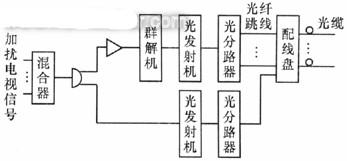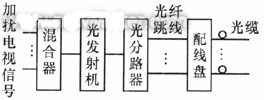4.2 System equipment installation and scrambling implementation steps
This article refers to the address: http://
(1) System front-end equipment installation
Because the preparation work is done more fully, the system equipment is successfully installed according to the instructions for use, and then the system is uniformly debugged according to the instructions for use and operational requirements. Some signals are inevitably stopped during the installation process, but the number and timing of signal cuts are minimized to minimize the impact on the user.
(2) Scrambling implementation steps
In accordance with the step-by-step implementation method, we first perform scrambling on the whole network in the area where the network quality is high, and then in the area where the network needs to be rectified, and the number of optical nodes scrambled each time according to the specific light. The number of users of the node and the number of users receiving the descrambler at the charging hall at that time are adjusted. This effect is better. The number of users received in the toll hall is basically in line with the workload of the staff, and the network is not too small to prolong the scrambling of the whole network. The cycle is not too much and there is confusion.
During the implementation of the descrambling process, both the scrambled and unscrambled television signals exist on the network, that is, the front end needs to output two different television signals. In order to solve this problem, some add one front end and output the scrambled and unscrambled TV signals from the two front ends respectively. The advantage of this is that the two TV signals do not affect each other, but if more TV programs are sent, the input is Too many, and the working time of one front end is very short. After the whole network is scrambled, it can only be idle, and it takes time and effort. The approach we take is:
Add one optical transmitter and optical splitter, and output the unscrambled signal (actually the descrambled signal) by the group solution at the front end. The power of this optical transmitter is the same as that of the original optical transmitter. The number of channels is the same as that of the original optical splitter. The split ratio of each channel is the same or roughly the same as the original. The two machines are installed on the same distribution frame as the original optical transmitter and the original optical splitter. Facilitate the connection of fiber jumpers. After the whole network is scrambled, there is one optical transmitter and optical splitter as the backup of the online equipment, which reduces the investment, saves time and effort. The connection of the front-end equipment during the implementation of the scrambling is shown in Figure 4.
(a) Full network scrambling implementation
(b) After the entire network is scrambled
Figure 4: Network-wide scrambling and the connection of the front-end after scrambling


4.3 System User Terminal General Troubleshooting
In the process of implementing scrambling, users will inevitably complain about faults. Most of the faults are non-descrambling or image instability. In addition to understanding the fault of the scrambler itself and the external power adapter, there are generally several reasons. Caused by:
(1) The input level is low (<55 dBRV). The low input level makes the data demodulation abnormal, so the normal image cannot be solved. The solution is to modify the line and increase the input level.
(2) The line contact is not good. Use the field strength meter to check that the input level is within the normal range, but the descrambler is not lit except the power indicator is on. This is to avoid the attenuation of the system. Data cannot be demodulated. Generally, data is inserted into a certain channel of the VHF band. If there is a bad contact on the cable transmission link, it will affect the channel of the VHF band and have no effect on the high-band signal, thus causing addressing. Authorization data cannot be demodulated. Another reason is that the user line is oxidized over a long period of time, or the user line F head is not in good contact with the brancher. The solution is to find a bad contact and replace the relevant parts.
(3) The position of the external sensor is not correct, so that the descrambler cannot obtain a sufficiently strong sensing signal, and thus the correct segment identification signal cannot be obtained, so that the normal descrambling cannot be performed. Generally, the radiation signal area of ​​a television set is large, so that a slightly moving sensor can quickly find a strong position of the sensing signal, so that the descrambler works normally.
(4) The video output signal is required. Nowadays, various high-end large-screen TVs have little or no radiation, and the sensor cannot obtain the sensing signal at any position of the TV. Therefore, the descrambler cannot obtain the normal segment identification signal and cannot be descrambled. There are various signal output jacks on the back of these TVs, one of which is the video output signal jack. The solution to this kind of fault is to use a video cable to invert the video output port of the TV set and the descrambler. Connect the sensor and switch the switch on the descrambler to the video end.
(5) The sensor signal cannot be input. There are very few brands of old-fashioned TVs with few radiated signals, the sensor can't find the best position, and the TV has no video output jack. In this case, users should choose a visual, audio output and RF output. A descrambler with a channel converter function.
(6) The mother machine works normally and the child machine does not disturb. This is a problem unique to the user who uses the child machine. This is because the second authorization period has expired and the secondary machine is not re-authorized or the card is not authorized. Because the machine is authorized by the front-end computer, it needs the parent machine. The IC card acts as a communication medium for secondary authorization of the slave, and has a certain period of use (in days) after the second authorization. Therefore, when this happens, it only needs to be given to the slave according to the normal secondary authorization method. Authorization can be, the second authorization is operated by the user, and the specific operation method is also very simple.
4.4 Experience and thinking
(1) After applying the descrambling system, the problem of charging is solved, and the management level is improved, and the statistics, control and management of the cable TV users can be accurately and effectively performed.
(2) Before applying the descrambling system, the network should be rectified so that the cable and various components are connected reliably, and the input level of the user terminal is guaranteed to be in the range of 60-80 dBuV, and the port with weak individual signals cannot be less than 55 dBuV, so scrambling can be done smoothly.
(3) The use of the user-side descrambler is simple and convenient, and it is preferable not to change the viewing habit of the user, which can greatly reduce the workload of the service.
(4) The user management software of the system should be appropriately modified and improved according to the actual situation of the locality, so that it is suitable for the user's consumption demand, making the management convenient, flexible and more humanized.
(5) The system should have a variety of scrambling modes, so that the system scrambling mode can be changed or upgraded at any time according to the application situation. There should be 2-3 kinds of scrambling modes in the same level to increase the difficulty of deciphering. In the case of acceptable price, the system scrambling method is best to use the scrambling technology for digital processing of analog TV signals, making the system more difficult to crack and enhance the security of the system.
5, the conclusion
After the cable TV application plus the descrambling system, it is beneficial to prevent the phenomenon of private connection and the network reliability, and also help to change the user's consumption concept and improve the standardization of cable TV management.
It's Made of Recycled Paper: The molded paper pulp enclosure is made from 100% post-consumer recycled paper. It's renewable, biodegradable, lightweight, cheap, and durable enough to ensure that each tab should last for many uses.
We have been using molded paper pulp in packaging projects for a while, and were impressed with the low cost and design flexibility. This seemed like a great opportunity to upcycle the material into a tech product enclosure. And the ability to perforate and tear the material makes it a natural choice for a tear-off thumb drive concept.
An Easier Way to Share: As product designers, we frequently run into problems sharing presentation and CAD files with clients. Because they often have firewalls, or might not be tech savvy, cloud sharing isn't always the best option. Burning DVDs is slow and impractical. And no one wants to leave behind their trusty (and pricey) 64GB thumb drive. We saw a need for a smaller pack of drives that could be shared and even left behind with the client.
Cheap USB Flash Drive,Biodegradable USB Flash Drive,Biodegradable Flash Drive,Biodegradable USB Stick
Custom Usb Gift company limited , https://www.customusbgift.com